SPOTLIGHT
R27m needed to get Eastern Cape EMS plan off the ground — but little indication of when funding will be available
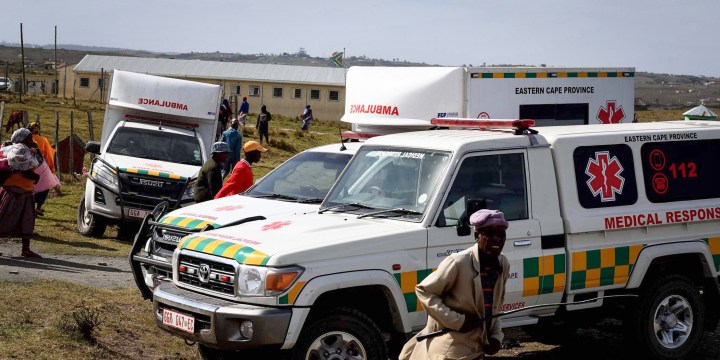
In October last year, Eastern Cape Health MEC Nomakhosazana Meth announced a three-phase plan to address key challenges with the province’s emergency medical services. Siyabonga Kamnqa visited All Saints Hospital in Ngcobo — one of the 28 priority hospitals targeted in the plan to see what progress has been made.
Gogo Nothembile Fanti (76) says she suffers from a heart condition and every time her grandchildren call an ambulance, they are told to wait, but it never arrives. She is one of about 40 patients — mostly older persons — sleeping on the floor and in chairs at All Saints Hospital in Ngcobo in the Eastern Cape during Spotlight’s visit on 30 January. They are all waiting for an ambulance to take them to referral hospitals such as Nelson Mandela Academic Hospital and Bedford Hospital about 60 kilometres away in Mthatha. They come from various villages around Ngcobo.
Fanti, like many other patients, says they are forced to sleep there overnight as the free transport provided by the hospital leaves at the crack of dawn.
“I had to call my neighbour to [bring] me here, otherwise I could have died waiting for the ambulance. They told me that I have to be taken to Mthatha to see a specialist, but having to sleep under these conditions at my age is a terrible experience,” she says.
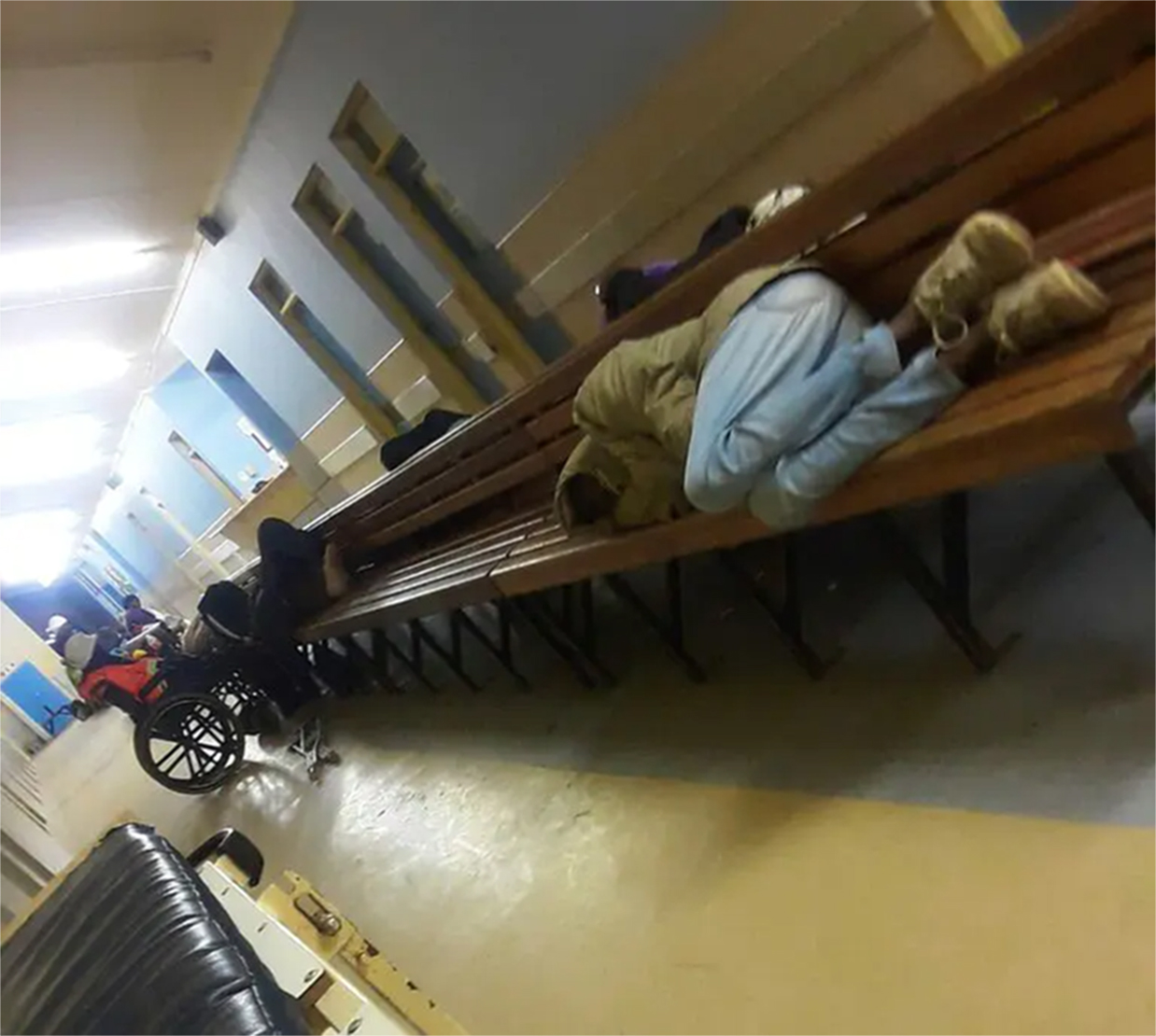
Some patients are forced to sleep in hospital waiting areas as the free transport provided by the hospital leaves at the crack of dawn for inter-hospital transfers. (Photo: Siyabonga Kamnqa/Spotlight)
An old problem
The challenges with patient transport, specifically emergency medical transport in the Eastern Cape, are not new. Spotlight has previously reported on the issue here, here, and here.
In October last year, Eastern Cape Health MEC Nomakosazana Meth in a response to a written question in the provincial legislature by DA MPL Jane Cowley said that there are 84 Emergency Medical Services (EMS) bases in the Eastern Cape — 16 of those are in the Chris Hani District where All Saints Hospital is situated.
Based on the numbers Meth provided, the district also has the highest vacancy rate — 65%. This means of the 796 posts available, there were 518 vacancies for EMS staff at the time of her response in October. Overall, for the whole province, the total posts were 3 269, but 1 202 were vacant at the time.
The province needs 671 ambulances based on its population but has 447 ambulances of which only 200 were rostered, meaning they were in service at the time. In Chris Hani District, they need at least 72 ambulances but only have 62 of which just 38 were rostered and on the road to provide a service.
Staff shortages and ambulances undergoing maintenance are among the reasons why there are not enough ambulances rostered in the province. Not one of the 84 EMS bases in the province complied with the national EMS regulations for personnel numbers.
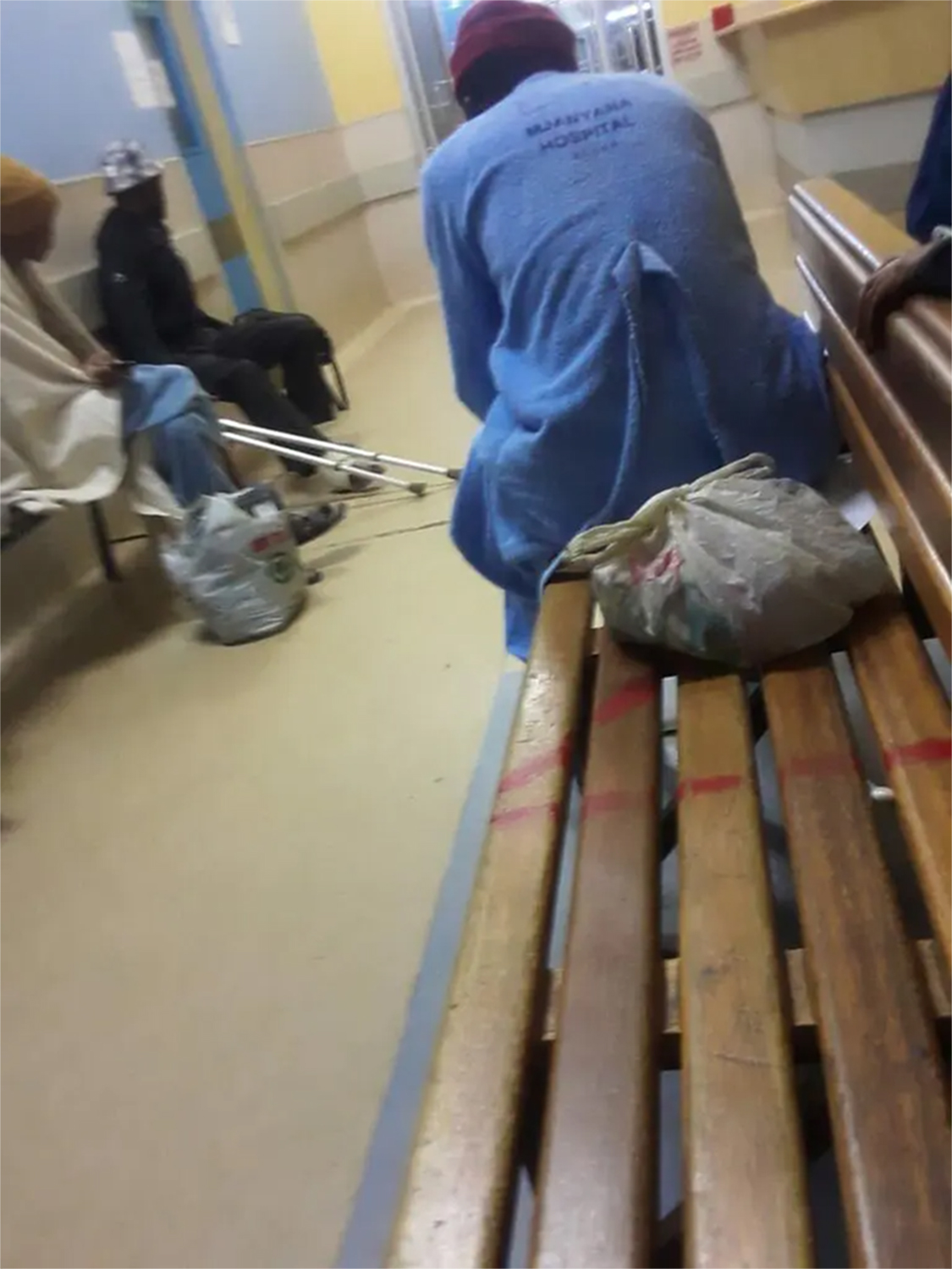
Staff shortages and ambulances undergoing maintenance are among the reasons why there are not enough ambulances rostered, especially in the rural areas in the Eastern Cape. (Photo: Siyabonga Kamnqa/Spotlight)
According to the DA’s provincial health spokesperson, Jane Cowley, there are 150 ambulances at any given time in for repairs. “The average turnaround time for repairs is a shocking 100 days — this is because they use the Government Fleet Management Services, who are owed in excess of R300-million by the [provincial health department] so they really don’t prioritise ambulance repairs.” She says the DA has been calling for the decentralisation of ambulance repairs and the development of public-private partnerships, which the party believes would speed up repair turnaround times dramatically.
Shouldering the burden
Providing some perspective on the impact this has on services and patient lives, a doctor says there are some districts where, at times, there is only one paramedic on duty per shift (the doctor spoke to Spotlight on condition of anonymity given the risks of reprisals from the health department). “When there is a serious call from opposite ends of the district, then you have to wait for the paramedic to deal with the one case, then come to the second. Patients in hospitals are deemed ‘less serious’ than if they are on the roadside. So, patients can wait for hours in a district hospital before being referred to a tertiary hospital. We recently had an elderly man with wet gangrene on his foot who waited in a casualty for two days. Then he died,” the doctor says.
The doctor says they often have a full casualty unit on Saturday nights. At times there may be four patients waiting for a referral. They may have gunshot wounds, been stabbed in the neck, and assaulted with a head injury. The casualty fills up as time passes and the number of patients waiting for referrals now grew by three, while the other four are still waiting in casualty. The three may be all orthopaedic patients. The doctor will ask the nurse about the patients and is told EMS said “no ambulances available”.
“Maybe you have the energy to paste this update on the EMS WhatsApp group. Maybe you try to phone someone yourself to escalate this issue. Maybe someone is able to contact the provincial office and request a private ambulance to assist. But by morning, there are still six patients waiting… then one dies. The oncoming team will now have to re-discuss these patients with the new team at the referral centre. The same thing happens day after day… patients miss appointments, have to be re-discussed, get a new date due to the perseverance of the doctors, then maybe miss another date due to EMS not being available… It is extremely exhausting for all concerned,” the doctor says.
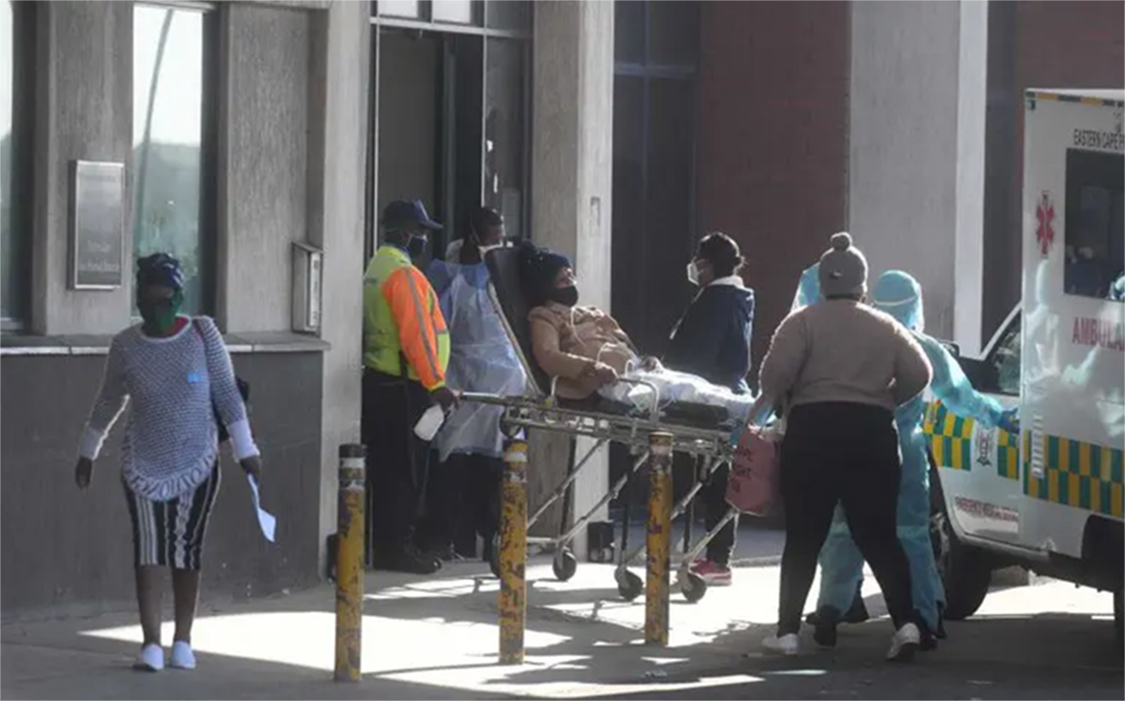
Some paramedics complain that ambulances often do not have adequate equipment. (Photo: Black Star/Spotlight)
Visit Daily Maverick’s home page for more news, analysis and investigations
According to two paramedics (who also spoke on condition of anonymity), they struggle with inadequate equipment in EMS vehicles. This, coupled with poor road infrastructure, often puts them under enormous pressure, they say. “Cellphone network also disappears during load shedding and this makes it impossible for patients to reach our services,” says one of the paramedics. “When we eventually arrive at the accident scene or at a sick patient, we are often met with insults from frustrated patients who said they’ve been trying to get hold of an ambulance for hours. Often, they forget about the challenges we face in trying to get to them on time,” he said.
Three-phased plan — yet to be financed
Meth in her parliamentary response last year said, “The[se] frequent transfers of patients put a heavy burden on the emergency medical services as there are no ambulances to do inter-facility transfers and therefore the emergency ambulances are used to transfer patients from hospitals to other hospitals over long distances with no ambulances left for emergency response at community level.” She said this is why there are often poor ambulance response times or no response at all.
In an attempt to address this, the provincial health department is working on a three-phased EMS plan targeting 28 hospitals across districts – among them All Saints.
This plan, however, will need funding to get off the ground.
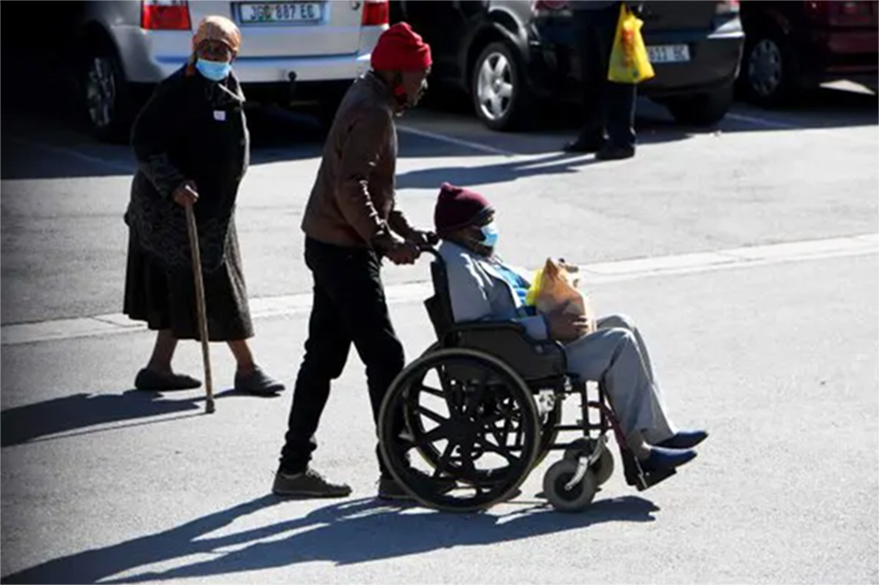
Often, emergency ambulances are used to transfer patients from hospitals to other hospitals over long distances, leaving no ambulances for emergency response at the community level. (Photo: Black Star/Spotlight)
Explaining the department’s three-phased plan, provincial health spokesperson Yonela Dekeda last week said the department plans to recruit additional personnel as funding becomes available and so did not provide timeframes. She says phase one is aimed at providing a dedicated inter-hospital transfer ambulance on a day-shift basis at the 28 priority hospitals. They aim to appoint 120 new staff members for this.
In phase two, the department wants to appoint an additional 120 personnel to make the day service a 24-hour service and phase three is to extend this to other hospitals and provide them with the personnel needed.
But, says Dekeda, the department will need R27 million and they expect funding only to be made available in the 2023/24 financial year.
Working to address EMS challenges
Meanwhile, she says, the department has been working to address the many challenges facing EMS in the province and there are some improvements. “These include the response rate to priority 1 calls (life-threatening calls). Over the past three quarters — ending December 2022 — the department has been meeting its targets for priority 1 calls by responding within 30 minutes (urban areas) and 60 minutes (rural areas).” She didn’t however specify what percentage of calls met these targets.
According to her, the department has taken a developmental approach to achieve compliance with the national EMS regulations. She says over the next three years there will be continued investments in infrastructure, equipment, staffing, and vehicles to promote compliance with the ideal promulgated in the regulations.
“We have purchased an additional 50 ECG monitors at a cost of R19-million to supplement the equipment in our ambulances as required by the regulations. About R15-million has been allocated to improving the infrastructure at selected EMS stations around the province and an additional allocation is expected in the next financial year to support the strategy,” she says.
In the current financial year, she says, the Engcobo Local Service Area where All Saints Hospital is located was allocated two intermediate life support practitioners.
Dekeda says the department’s priority remains emergency patient care, so the majority of the current resources are still allocated to this.
“We are using our staff interchangeably between planned patient transport and the emergency transport service. One will understand that the planned patient transport works on weekdays (Monday to Friday) while emergency ambulance services are a seven-day operation, 24 hours a day. We are committed to increasing the number of staff on the emergency transport and then developing a separate staff complement for the planned patient transport service.”
Dekeda also says recruiting more staff is coupled with interventions to have the district hospitals offer the appropriate package of services, which will reduce the number of trips transferring patients. She says by employing dedicated teams to manage transfers of patients at the 28 priority hospitals as part of the three-phased plan, the hope is to improve the overall responsiveness of the ambulance fleet.
“We will continue with this recruitment in the next financial year and also focus on the operational staff to assist with the transfers of critical patients. All Saints is one of the district hospitals that will benefit,” she stresses.
‘A total mess’
But some Eastern Cape residents remain sceptical.
Responding to the new plans, activist and community leader from Xhora Mouth, Phumzile Msaro says they are tired of empty promises. “This EMS problem is going to be with us for a long time as long as there are still unreliable people at the top. Every day we are faced with challenges as rural dwellers. Just yesterday (9 February), I called an ambulance for an elderly villager from Xhora Mouth who had fits. The assistants at the call centre lied and said the ambulance was on its way but we waited all day, only for the ambulance to arrive at 7 pm after a number of frantic calls throughout the day. The elderly person only managed to arrive and get assistance at Madwaleni Hospital at 9 pm. We keep hearing about all these so-called plans but nothing gets implemented on the ground. It’s a total mess,” he says.
Cowley echoes these sentiments. She says due to ambulance shortages and the severe shortage of EMS personnel, especially advanced life support paramedics, ambulance turnaround times are very slow, particularly in rural areas. “People can wait up to a day for an ambulance and sometimes that is too late. They have many plans but cannot seem to implement them as there is no political will to do so. It’s just a talk shop. In all my extensive oversight visits, the constant and main complaint is the lack of or slow ambulance service.” DM/MC
*This article was published by Spotlight – health journalism in the public interest.






















 Become an Insider
Become an Insider
Comments - Please login in order to comment.